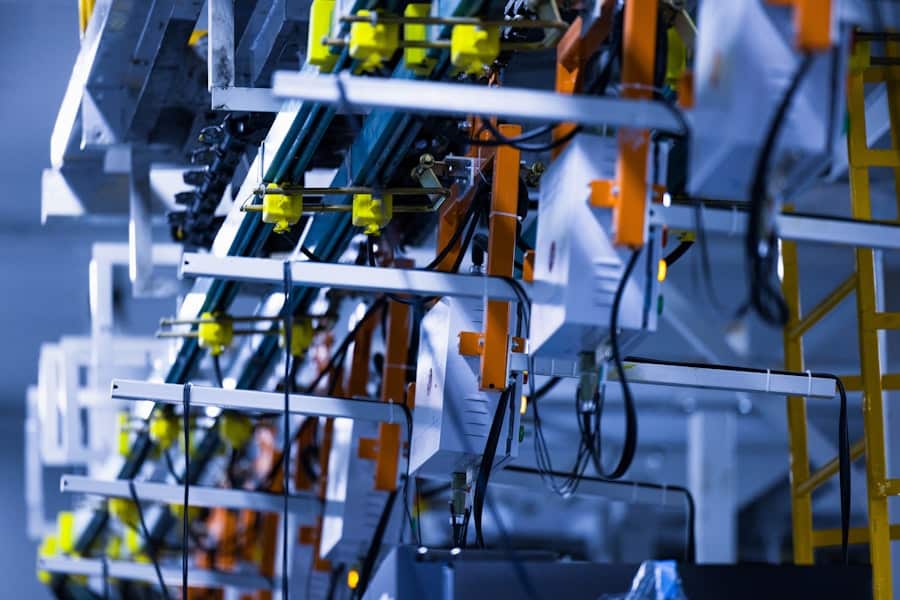The semiconductor industry stands as a cornerstone of modern technology, powering everything from smartphones to supercomputers. As the demand for smaller, faster, and more efficient electronic devices continues to surge, the need for advanced manufacturing techniques has never been more critical. Automation has emerged as a transformative force within this sector, reshaping how semiconductors are designed, fabricated, and tested.
By integrating automated systems into various stages of production, companies can enhance precision, reduce human error, and streamline operations. This shift towards automation is not merely a trend; it represents a fundamental evolution in how semiconductor manufacturing is approached. The integration of automation technologies in semiconductor manufacturing encompasses a wide array of processes, including wafer fabrication, assembly, and testing.
These processes are characterized by their complexity and the need for high levels of precision.
As the industry grapples with increasing production demands and the intricacies of advanced technology nodes, automation provides a viable solution to meet these challenges head-on.
Key Takeaways
- Automation in the semiconductor industry refers to the use of advanced technology and robotics to streamline manufacturing processes and increase efficiency.
- Advantages of automation in semiconductor manufacturing include improved precision, reduced labor costs, increased production speed, and enhanced safety for workers.
- Robotics play a crucial role in semiconductor fabrication by performing tasks such as wafer handling, inspection, and packaging with high accuracy and consistency.
- Automation has a significant impact on quality control in the semiconductor industry by minimizing human error, ensuring uniformity, and detecting defects at an early stage.
- The importance of automation in increasing efficiency and productivity in the semiconductor industry cannot be overstated, as it leads to higher output and cost savings.
- Challenges and limitations of automation in semiconductor manufacturing include high initial investment, complex integration of different systems, and the need for skilled technicians to operate and maintain automated equipment.
- Future trends and innovations in automation for the semiconductor industry include the adoption of artificial intelligence, machine learning, and advanced robotics to further enhance manufacturing processes.
- In conclusion, the continued importance of automation in the semiconductor industry is evident in its ability to drive innovation, improve quality, and meet the growing demand for semiconductor products in a competitive global market.
Advantages of Automation in Semiconductor Manufacturing
One of the most significant advantages of automation in semiconductor manufacturing is the enhancement of operational efficiency. Automated systems can operate continuously without the fatigue or variability associated with human labor. This leads to increased throughput, allowing manufacturers to produce more chips in less time.
For instance, automated wafer handling systems can transport wafers between different processing stations with minimal delay, ensuring that production lines run smoothly and efficiently. This not only accelerates the manufacturing process but also helps in meeting tight deadlines imposed by market demands. Moreover, automation contributes to improved consistency and quality in semiconductor production.
Automated processes are governed by precise algorithms and control systems that minimize variations in production parameters. This level of control is crucial in semiconductor fabrication, where even minute deviations can lead to defects or subpar performance in the final product. For example, automated photolithography systems can achieve higher resolution and accuracy than manual methods, resulting in better-defined patterns on silicon wafers.
Consequently, the integration of automation leads to a reduction in defect rates and an overall enhancement in product reliability.
Role of Robotics in Semiconductor Fabrication

Robotics plays a pivotal role in the automation landscape of semiconductor fabrication. Robotic systems are employed for various tasks, including material handling, assembly, and inspection. These robots are designed to operate in cleanroom environments, where contamination control is paramount.
For instance, robotic arms equipped with specialized end-effectors can handle delicate silicon wafers with precision, reducing the risk of damage during transport between processing stations. This capability is essential in maintaining the integrity of wafers throughout the fabrication process. In addition to material handling, robotics is increasingly utilized for inspection and quality assurance tasks within semiconductor manufacturing.
Automated optical inspection (AOI) systems leverage advanced imaging technologies to detect defects on wafers at various stages of production. By employing high-resolution cameras and sophisticated algorithms, these systems can identify anomalies that may be invisible to the human eye. The implementation of robotics in inspection processes not only enhances defect detection rates but also accelerates the overall quality control workflow, allowing manufacturers to address issues promptly and efficiently.
Impact of Automation on Quality Control in the Semiconductor Industry
Quality control is a critical aspect of semiconductor manufacturing, as even minor defects can lead to significant performance issues in electronic devices. Automation has revolutionized quality control processes by introducing advanced monitoring and inspection technologies that ensure adherence to stringent quality standards. Automated systems can continuously monitor production parameters in real-time, allowing for immediate adjustments if deviations are detected.
This proactive approach minimizes the risk of producing defective products and enhances overall yield rates. Furthermore, data analytics plays a crucial role in automated quality control within the semiconductor industry. By collecting and analyzing vast amounts of data generated during the manufacturing process, companies can identify trends and patterns that may indicate potential quality issues.
For example, machine learning algorithms can analyze historical data to predict when equipment may require maintenance or when specific production parameters may lead to defects. This predictive capability enables manufacturers to implement corrective actions before problems escalate, ultimately leading to improved product quality and reduced waste.
Importance of Automation in Increasing Efficiency and Productivity
The importance of automation in enhancing efficiency and productivity within semiconductor manufacturing cannot be overstated. As the industry faces increasing pressure to produce more advanced chips at lower costs, automation provides a pathway to achieve these goals without compromising quality. Automated systems can operate around the clock, significantly increasing production capacity while minimizing downtime associated with human labor shifts or breaks.
Moreover, automation allows for better resource management within semiconductor manufacturing facilities. By optimizing workflows and reducing manual intervention, companies can allocate their human resources more effectively. For instance, skilled workers can focus on higher-value tasks such as process optimization or equipment maintenance rather than routine manual operations.
This shift not only enhances productivity but also fosters a more skilled workforce capable of driving innovation within the industry.
Challenges and Limitations of Automation in Semiconductor Manufacturing

Despite its numerous advantages, the implementation of automation in semiconductor manufacturing is not without challenges and limitations. One significant hurdle is the high initial investment required for automated systems and technologies. The cost of acquiring advanced robotics, software solutions, and infrastructure upgrades can be substantial, posing a barrier for smaller manufacturers or those operating on tight budgets.
Additionally, ongoing maintenance and updates for these systems can further strain financial resources. Another challenge lies in the complexity of integrating automation into existing manufacturing processes. Many semiconductor facilities have legacy systems that may not be compatible with modern automated solutions.
The transition to fully automated operations often requires significant re-engineering of workflows and processes, which can be time-consuming and disruptive to ongoing production activities. Furthermore, there is a need for skilled personnel who can operate and maintain these advanced systems; a shortage of such talent can hinder the successful implementation of automation initiatives.
Future Trends and Innovations in Automation for Semiconductor Industry
As technology continues to evolve at an unprecedented pace, the future of automation in the semiconductor industry is poised for exciting developments. One notable trend is the increasing adoption of artificial intelligence (AI) and machine learning (ML) technologies within automated systems. These technologies enable manufacturers to analyze vast datasets generated during production more effectively, leading to enhanced decision-making capabilities and improved process optimization.
Additionally, advancements in collaborative robotics—often referred to as cobots—are set to transform semiconductor manufacturing environments. Unlike traditional industrial robots that operate independently within safety cages, cobots are designed to work alongside human operators safely. This collaboration allows for greater flexibility in production lines and enables manufacturers to leverage human intuition and creativity alongside automated precision.
Another promising area is the integration of Internet of Things (IoT) technologies into semiconductor manufacturing processes. IoT devices can provide real-time monitoring and data collection from various stages of production, facilitating better visibility into operations and enabling predictive maintenance strategies. This interconnectedness will likely lead to smarter factories where automated systems communicate seamlessly with one another, optimizing workflows and enhancing overall efficiency.
The Continued Importance of Automation in the Semiconductor Industry
The role of automation in the semiconductor industry is undeniably critical as manufacturers strive to meet growing demands for advanced electronic devices while maintaining high standards of quality and efficiency. The advantages offered by automation—ranging from increased productivity to enhanced quality control—underscore its importance as a driving force behind innovation within this sector.
Looking ahead, the future promises even greater integration of cutting-edge technologies such as AI, collaborative robotics, and IoT into automated systems. These innovations will not only enhance operational efficiency but also pave the way for new possibilities in semiconductor design and fabrication processes. As the industry evolves, embracing automation will remain essential for manufacturers seeking to maintain competitiveness in an increasingly dynamic market environment.
In the rapidly evolving semiconductor industry, automation plays a crucial role in enhancing efficiency and precision. As the demand for advanced technology grows, the need for automated processes becomes increasingly vital to meet production and innovation goals. A related article that delves into the importance of selecting the right technology tools, such as laptops for specific tasks, can be found in the discussion on how to choose a laptop for video editing. This article highlights the significance of choosing the right equipment to optimize performance, which parallels the necessity of automation in the semiconductor sector to streamline operations and maintain competitive advantage.
FAQs
What is the semiconductor industry?
The semiconductor industry is the sector of the electronics industry that produces semiconductors, which are materials with electrical conductivity between that of a conductor and an insulator.
Why is automation essential in the semiconductor industry?
Automation is essential in the semiconductor industry because it helps improve efficiency, reduce human error, increase production capacity, and lower production costs.
How does automation benefit the semiconductor industry?
Automation benefits the semiconductor industry by enabling continuous production, improving quality control, reducing cycle times, and enhancing overall productivity.
What are some examples of automation in the semiconductor industry?
Examples of automation in the semiconductor industry include robotic arms for handling wafers, automated testing equipment, and advanced manufacturing processes controlled by computer systems.
What are the challenges of implementing automation in the semiconductor industry?
Challenges of implementing automation in the semiconductor industry include high initial investment costs, the need for specialized technical expertise, and the potential for job displacement.

